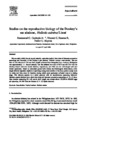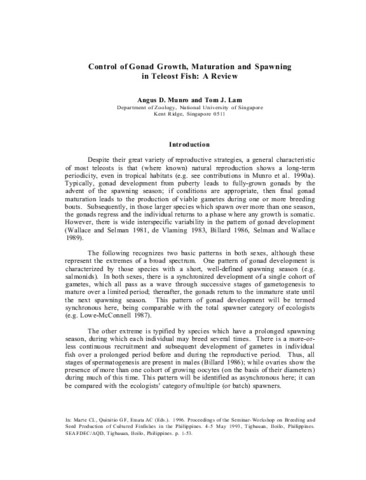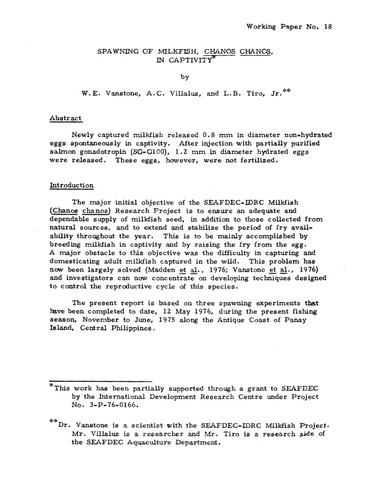Studies on the reproductive biology of the Donkey's ear abalone, Haliotis asinina Linné
Share
Abstract
The sex ratio, initial size at sexual maturity, spawning period, time interval between successive spawnings and fecundity of the Donkey's ear abalone, Haliotis asinina were studied. The sex ratio of wild abalone (>60 mm shell length) collected from Panagatan Cays, Antique, Philippines was approximately 1:1. Sexual maturity was first attained at a size of 35.0 mm and 35.9 mm for hatchery-reared male and female abalone, respectively, and 40.6 mm for wild-caught male and female specimens. Based on calculated gonad bulk indices and histological observations, wild-caught abalone appeared capable of spawning during most months of the study period except June for males and May–June for females, during which most specimens collected were at a resting stage. This abalone species is a serial spawner with an asynchronous spawning behavior. Hatchery-reared abalone have short time intervals between successive spawnings of 13–15 days. Ripe females measuring 58.1–69 mm in shell length may release about 150,000 to 600,000 eggs per spawning.
Suggested Citation
Capinpin, E. C., Jr., Encena II, V. C., & Bayona, N. C. (1998). Studies on the reproductive biology of the Donkey's ear abalone, Haliotis asinina Linné. Aquaculture , 166(1-2), 141-150. https://doi.org/10.1016/S0044-8486(98)00275-0
Subject
Collections
- AQD Journal Articles [1248]
Related items
Showing items related by title, author, creator and subject.
-
Aquaculture-based Enhancement and Restoration of Many-colored Abalone Resources (Haliotis diversicolor Reeve, 1846) in Bach Long VI National Marine Protected Area, Vietnam
Chieu, Hoang Dinh; Phuong, Lai Duy; Duy, Do Anh; Tuan, Bui Minh; Thoa, Nguyen Kim (Training Department, Southeast Asian Fisheries Development Center, 2016)Many-colored abalone (Haliotis diversicolor) is high commercial species in Vietnam. Meanwhile, these resources have been over-exploited, thus, artificial breeding was implemented to restore natural abalone resources. After ... -
Control of gonad growth, maturation and spawning in teleost fish: A review
Munro, Angus D.; Lam, Tom J. (Aquaculture Department, Southeast Asian Fisheries Development Center, 1996)Despite their great variety of reproductive strategies, a general characteristic of most teleosts is that (where known) natural reproduction shows a long-term periodicity, even in tropical habitats (e.g. see contributions ... -
Spawning of milkfish, Chanos chanos, in captivity
Vanstone, William E.; Villaluz, Antonio C.; Tiro Jr., Leonardo B. (Aquaculture Department, Southeast Asian Fisheries Development Center, 1976)Newly captured milkfish released 0.8 mm in diameter non-hydrated eggs spontaneously in captivity. After injection with partially purified salmon gonadotropin (SG-G100), 1.2 mm in diameter hydrated eggs were released. These ...





